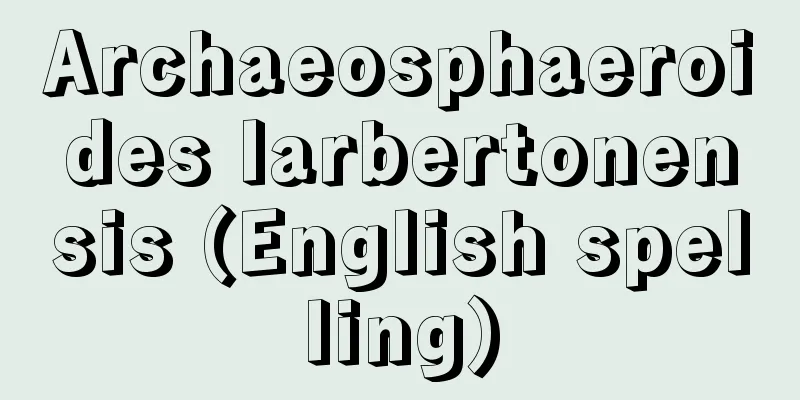end rhyme

|
In verse, a phrase or ending at the end of a sentence has a musical effect by echoing the previous or following lines of verse through homophones or similar sounds. It is the opposite of alliteration. In Japan, various European styles of poetry were introduced after the Meiji period, so alliteration and rhyme in Japanese tend to follow rules somewhat forcibly. There are strict rules for rhyme in Western-style iambic feet and sonnets, and the echo of tones in verse poetry brings heroism and elegance, like the harmony of music and dance. Considering the evolution of Chinese poetry, literary fixed-form poetry (→ fixed-form poetry), and colloquial free verse (→ free verse), there are very few rhyming poems with alliteration and rhyme in modern times, and the transition to prose poetry is noticeable worldwide. In Japan, 5-7 and 7-5 rhymes flow unconsciously, and this fixed form has been passed down from ancient folk songs and the Manyoshu to modern tanka (→ tanka) and haiku. An example of rhyme and alliteration in modern and contemporary poetry is the following: "The bamboo grows sharply on the ground, / The bamboo grows straight, / With the frozen joints ringing, / Under the blue sky, the bamboo grows, / Bamboo, bamboo, bamboo grows." (Part of "Take" from Hagiwara Sakutaro's Tsuki ni Hoeru (Howling at the Moon), 1917). The "e" sound in "take" and "grow" heightens the sense of pathological urgency. "Kappa rappa kapparatta / Totte chitte ta / Kappa nappa katt / Kappa nappai ippa katt / Katte kitter katt" (Part of "Kappa" from Tanikawa Shuntaro's Kotoba asobi uta (Word Play Songs), 1981). The lightness of the sounds "ka, pa, ta" and the use of short consonants. The correspondence between alliteration and rhyme is interesting. Source: Encyclopaedia Britannica Concise Encyclopedia About Encyclopaedia Britannica Concise Encyclopedia Information |
|
韻文において,文末の語句,語尾が同音や類音によって前後の詩行と呼応した音楽的効果をもつもの。頭韻に対していう。日本では明治期以後,ヨーロッパのさまざまな詩歌様式が混入したため,日本語における頭韻・脚韻は,やや強引に法則に従う傾向がある。西洋式のアイアンブ(弱強格の韻脚)やソネットでの脚韻には厳密な法則があり,韻文詩における語調の呼応は音楽と踊りの調和のように勇壮さや優美さをもたらす。漢詩文,文語定型詩(→定型詩),口語自由詩(→自由詩)の変遷を考えると,現代では頭韻・脚韻の押韻詩(→押韻)はきわめて少なく,世界的にも散文詩への移行が顕著である。日本の場合は五七調,七五調の韻文が無意識下に流れ,上代歌謡や『万葉集』等から現代短歌(→短歌),俳句にその定型性が受け継がれている。近代,現代詩の脚韻・頭韻の一例としては次のような作品があげられる。「地上にするどく竹が生え,/まっしぐらに竹が生え,/凍れる節々りんりんと,/青空のもとに竹が生え,/竹,竹,竹が生え。」(萩原朔太郎『月に吠える』〈1917〉の「竹」の一部)。「竹」,「生え」の「エ」の音が病的な衝迫感をつのらせる。「かっぱらっぱかっぱらった/とってちってた/かっぱなっぱかった/かっぱなっぱいっぱかった/かってきってくった」(谷川俊太郎『ことばあそびうた』〈1981〉の「かっぱ」の一部)。「カ,パ,タ」の音と促音便の軽快感。頭韻と脚韻の呼応におもしろさがある。
出典 ブリタニカ国際大百科事典 小項目事典ブリタニカ国際大百科事典 小項目事典について 情報 |
Recommend
Urasenke - Urasenke
One of the schools of tea ceremony founded by Sen...
Tristan L'Hermite
...Coinciding with the start of the cultural poli...
Ochlodes venata (English spelling)
...When they do this, they leave behind bite mark...
Poetry of Ecstasy
Symphony No. 4 (1904-1907) by the Russian composer...
Adam of Saint Victor - Adam of Saint Victor
...The cathedral of Metz was the leading center o...
Shadow Sickness
= Shadow troubles ※Joruri, Akazomeemon Eiga Monoga...
Geraniol - Geraniol (English spelling)
A representative acyclic monoterpene alcohol with...
Moharaso - Moharanosho
During the Heian period, this manor was located in...
Tamaoya Shrine - Tamaoya Shrine
Located in Osaki, Hofu City, Yamaguchi Prefecture...
Phycobilin - Phycobilin (English spelling)
A pigment found in the chloroplasts of algae. The ...
Kasuga version - Kasugaban
This refers to Buddhist scriptures published at K...
Ager Publicus
Public land in ancient Rome. In the course of its ...
Jishu death register - Jishu Kakocho
Also known as the Ougo no Kakocho (Records of Anci...
Challenging student - Ayanosho
...The origin of this group was a group of crafts...
reasonable expectation
…D. Hume and A. Smith are representative of this ...





![Bisei [town] - Bisei](/upload/images/67cc9d4ce3180.webp)



